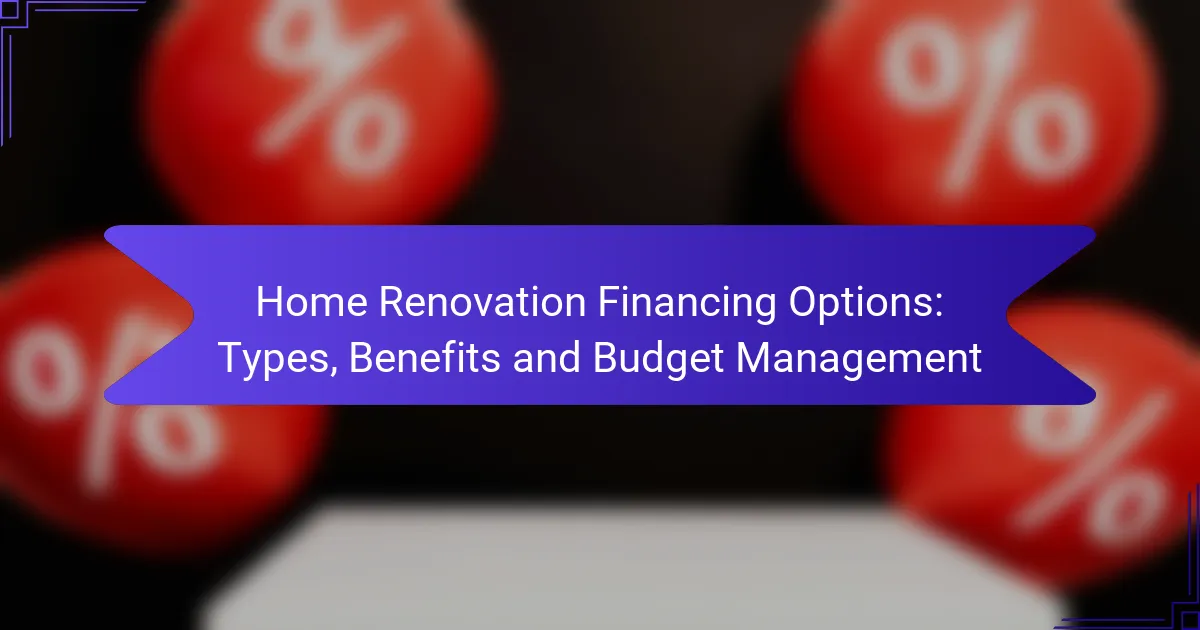Home renovation financing offers various options, such as home equity loans, personal loans, and renovation mortgages, each tailored to meet different financial needs. By understanding the benefits and considerations of these options, homeowners can effectively manage costs and enhance their properties. Proper budgeting is crucial to ensure that renovation expenses are controlled and repayment plans are sustainable.

What are the best home renovation financing options in South Africa?
The best home renovation financing options in South Africa include home equity loans, personal loans, renovation mortgages, government grants, and credit cards. Each option has its own benefits and considerations, making it essential to evaluate them based on your financial situation and renovation needs.
Home equity loans
Home equity loans allow homeowners to borrow against the equity built up in their property. Typically, these loans offer lower interest rates compared to unsecured loans since they are secured by the home itself.
When considering a home equity loan, ensure you have sufficient equity—generally, lenders prefer at least 20% equity. Be aware of the risks; if you default, you could lose your home.
Personal loans
Personal loans are unsecured loans that can be used for home renovations. They usually have higher interest rates than secured loans but are quicker to obtain, often requiring minimal documentation.
When opting for a personal loan, compare interest rates and terms from various lenders. Look for loans with no prepayment penalties to avoid fees if you pay off the loan early.
Renovation mortgages
Renovation mortgages combine the cost of purchasing a home and the expenses of renovations into a single mortgage. This option is ideal for buyers looking to purchase a fixer-upper.
These mortgages typically require a detailed renovation plan and may involve higher interest rates. Ensure you work with a lender familiar with these types of loans to navigate the process effectively.
Government grants
Government grants are available for specific renovation projects, particularly those aimed at improving energy efficiency or accessibility. These grants do not require repayment, making them an attractive option.
Eligibility for government grants often depends on income levels and the nature of the renovations. Research local programs to see what is available in your area and ensure you meet the criteria.
Credit cards
Using credit cards for home renovations can be convenient, especially for smaller projects. Many credit cards offer rewards or cash back, which can be beneficial if you pay off the balance promptly.
However, be cautious of high-interest rates associated with credit cards. It’s advisable to only use this option if you can pay off the balance within a short period to avoid accumulating debt.

What are the benefits of home renovation financing?
Home renovation financing offers several advantages, including access to immediate funds, improved property value, flexible repayment terms, and potential tax benefits. These options can help homeowners manage costs effectively while enhancing their living spaces.
Access to immediate funds
Home renovation financing provides quick access to the funds needed for projects, allowing homeowners to start renovations without depleting savings. This can be particularly useful for urgent repairs or upgrades that enhance safety and comfort.
Options such as personal loans, home equity lines of credit (HELOCs), or credit cards can offer immediate cash flow. It’s essential to compare interest rates and terms to find the most suitable option for your financial situation.
Improved property value
Investing in home renovations can significantly increase the property’s market value. Upgrades such as kitchen remodels, bathroom renovations, or energy-efficient installations often yield high returns when selling the home.
Homeowners should consider focusing on projects that are popular in their area to maximize value. Researching local real estate trends can provide insights into which renovations are most likely to attract buyers.
Flexible repayment terms
Many home renovation financing options come with flexible repayment plans, allowing homeowners to choose terms that fit their budget. This flexibility can ease financial strain and help manage monthly expenses more effectively.
For instance, a HELOC typically allows for interest-only payments during the draw period, while personal loans may offer fixed monthly payments over a set term. Evaluating these options can help homeowners select a plan that aligns with their financial goals.
Tax benefits
Homeowners may be eligible for tax deductions on interest paid for certain types of renovation financing, particularly if the funds are used for improvements that enhance energy efficiency or increase property value. This can reduce the overall cost of financing renovations.
Consulting a tax professional is advisable to understand the specific deductions available and ensure compliance with current tax regulations. Keeping detailed records of expenses related to renovations can also facilitate tax filing.

How to budget for home renovation financing?
Budgeting for home renovation financing involves understanding your total costs, determining how much you need to borrow, and planning for repayment. A clear budget helps you manage expenses effectively and avoid financial strain during the renovation process.
Estimate renovation costs
Start by creating a detailed list of all renovation tasks and materials needed. Research costs for labor, supplies, and any permits required in your area. For a typical kitchen remodel, costs can range from a few thousand to tens of thousands of dollars, depending on the scope of work.
Consider getting quotes from multiple contractors to ensure you have a realistic estimate. This will help you avoid underestimating costs and running into budget overruns later on.
Determine financing needs
Once you have a clear estimate of renovation costs, assess how much financing you will require. This includes not only the total project cost but also any additional expenses such as unexpected repairs or upgrades. A common guideline is to budget an extra 10-20% for unforeseen issues.
Evaluate different financing options, such as personal loans, home equity lines of credit, or renovation-specific loans, to find the best fit for your financial situation.
Set a repayment plan
Establish a repayment plan that aligns with your budget and financial goals. Determine how long you want to take to pay off the loan and what monthly payments you can comfortably afford. For example, if you borrow $20,000 at a 5% interest rate, your monthly payment over five years would be approximately $377.
Be sure to factor in your other financial obligations to avoid overextending yourself. Setting up automatic payments can help ensure you stay on track with your repayment schedule.
Consider contingencies
Contingencies are essential in any renovation budget. Set aside a portion of your budget, typically around 10-15%, specifically for unexpected expenses that may arise during the project. This can cover anything from hidden structural issues to changes in material costs.
Regularly review your budget and adjust your contingency fund as needed throughout the renovation process. This proactive approach can help you manage stress and keep your project on track financially.

What criteria should you consider when choosing a financing option?
When selecting a financing option for home renovation, consider interest rates, loan terms, fees, and approval time. These factors significantly impact the overall cost and feasibility of your project.
Interest rates
Interest rates determine how much you will pay over the life of the loan. Lower rates can save you hundreds or even thousands of dollars, so it’s crucial to shop around and compare offers. Fixed rates provide stability, while variable rates may start lower but can increase over time.
For home renovation loans, interest rates typically range from low single digits to high single digits, depending on your credit score and the lender. Aim for the lowest possible rate to minimize your total repayment amount.
Loan terms
Loan terms refer to the duration you have to repay the loan, which can range from a few months to several years. Shorter terms usually mean higher monthly payments but less interest paid overall, while longer terms can lower monthly payments but increase total interest costs.
Common loan terms for home renovations are 5, 10, or 15 years. Consider your budget and cash flow to choose a term that balances affordability with total cost.
Fees and charges
Fees and charges can add significantly to the cost of your financing option. Look for origination fees, closing costs, and prepayment penalties, which can vary widely among lenders. Understanding these fees upfront helps you avoid surprises later.
Some lenders may offer no-fee loans, but they might come with higher interest rates. Always calculate the total cost of the loan, including fees, to make an informed decision.
Approval time
Approval time is the duration it takes to get your loan approved and funded. This can range from a few days to several weeks, depending on the lender and the complexity of your application. Faster approval can be crucial if you need to start renovations quickly.
To expedite the process, ensure you have all necessary documentation ready, such as income verification and credit history. Some lenders offer pre-approval options, which can streamline the funding process significantly.

How do home renovation loans compare to personal loans?
Home renovation loans and personal loans serve different purposes, but both can be used to finance home improvement projects. Home renovation loans are typically secured against the property, while personal loans are unsecured, which affects their terms and eligibility requirements.
Interest rates comparison
Interest rates for home renovation loans are generally lower than those for personal loans because they are secured by the property. Home renovation loans may offer rates ranging from 3% to 7%, while personal loans often have rates between 6% and 36%, depending on creditworthiness.
When considering interest rates, it’s essential to evaluate your credit score and financial situation. A higher credit score can significantly lower the interest rate on personal loans, making them more competitive.
Loan amounts comparison
Home renovation loans typically allow for larger loan amounts compared to personal loans, often ranging from $10,000 to $100,000 or more, depending on the home’s equity. In contrast, personal loans usually cap out at lower amounts, often between $1,000 and $50,000.
Before choosing a loan type, assess the total cost of your renovation project. If your project requires a substantial budget, a home renovation loan may be more suitable due to its higher limits and lower interest rates.
